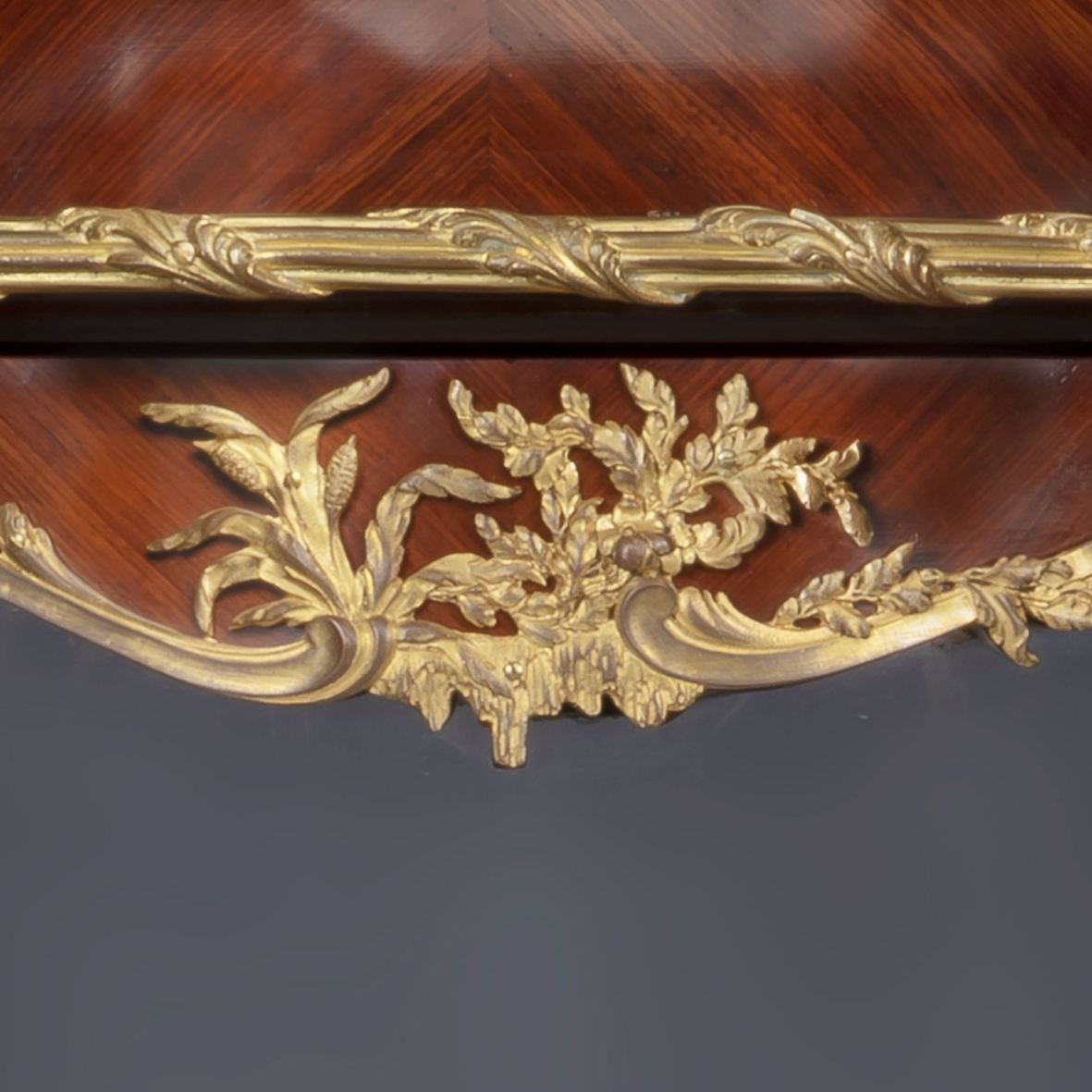Emmanuel Zwiener
A Rare Louis XVI Style Gilt-Bronze Mounted Wall Vitrine
£38,000
A Rare and Unusual Louis XVI Style Gilt-Bronze Mounted Wall Vitrine by Emmanuel Zwiener. This rare wall vitrine has a domed top with gilt-bronze acanthus...
Dimensions
Height: 143 cm (57 in)Width: 70 cm (28 in)
Profondeur : 30 cm (12 in)
Description
A Rare and Unusual Louis XVI Style Gilt-Bronze Mounted Wall Vitrine by Emmanuel Zwiener.
This rare wall vitrine has a domed top with gilt-bronze acanthus mounts, surmounted by an urn issuing flowers. The shaped front and side panels have curved glass and are framed by exceptional gilt-bronze foliate mounts above a bombe shaped apron with a foliate gilt bronze terminal. The interior with a mirrored back and two shelves, on scrolled apron. An example of this vitrine is illustrated by Christopher Payne in his book ‘Paris Furniture: The Luxury Market of the 19th Century’; p. 568.
France, Circa 1890.
Date
Circa 1890
Origine
France
Moyen
Verre coupé
Signature
Signed ‘E. Zwiener’ to the base of the bronze mount to one door. The reverse of the bronze mounts stamped ‘NZ’.
Les frères Zwiener, Emmanuel et Julius, ont produit certains des meubles de luxe les plus innovants de la fin du XIXe siècle. Ils ont développé un style unique qui mêlait le haut rococo fleuri de la période Louis XV à des influences Art nouveau contemporaines. Ils ont employé le sculpteur Léon Messagé, à qui l'on doit la création des motifs rococo naturalistes pour lesquels Zwiener a reçu une médaille d'or à l'Exposition universelle de Paris de 1889. Léon Messagé a également conçu des pièces d'exposition pour le contemporain de Zwiener, François Linke, et l'on a supposé que Linke avait peut-être travaillé pour Zwiener lors de son arrivée à Paris en 1875. Il n'est donc pas surprenant qu'il y ait tant de similitudes stylistiques entre les meubles de Zwiener et de Linke ou qu'ils soient les ébénistes parisiens les plus prisés et les plus célèbres de la Belle Époque.
Les recherches les plus récentes indiquent qu'il y avait trois frères Zwiener originaires de Herdon, en Allemagne. Le frère aîné Joseph avait, dans les années 1880, établi un atelier important dans la ville de Breslau en Silésie, aujourd'hui en Pologne occidentale. Ses frères cadets Emmanuel et Julius travaillaient, à la même époque, à Paris. Enregistrés à partir de 1880 avec des ateliers au 12, rue de la Roquette, ils se sont établis comme les premiers ébénistes de haut luxe de l'époque, produisant d'élégants meubles reproduisant des modèles royaux du Garde-Meuble National de France, notamment une réplique du célèbre bureau de Roi de Jean-Henri Riesener et Jean-François Oeben qui a été fourni à Louis II à Herrenchiemsee et placé dans le bureau du Roi en 1884. Leurs propres créations variaient une interprétation dynamique du style rococo français. Les meubles de Zwiener sont souvent incrustés de la marqueterie la plus fine et sertis de montures figuratives en bronze doré au modelé ambitieux. En 1895, après avoir reçu une importante commande royale de l'empereur Guillaume II de Prusse, Julius retourne à Berlin pour créer ses propres ateliers. La même année, son frère Emmanuel se retire en vendant les ateliers du 12, rue de la Roquette pour 10 000 francs à Jean-Henri Jansen (1854-1929), fondateur de la Maison Jansen. C'est à cette époque que l'on trouve des meubles Zwiener estampillés à la fois par Zwiener et Jansen.
La production de Zwiener a culminé avec l'obtention de la très convoitée médaille d'or pour un cabinet de serre-bijoux décoré de vernis Martin de style rococo à l'Exposition universelle de Paris en 1889. Il est ensuite entré dans la collection de l'impératrice Maria Feodorovna de Russie à Gatchina et a été vendu récemment à Londres en 2011. Le jury de l'exposition de 1889 a noté que "dès ses débuts d'une Exposition universelle, [il] s'est mis au premier rang par la richesse, la hardiesse et le fini de ses meubles incrustés de bronzes et fort habilement marquetés". De nombreuses pièces exécutées par Zwiener pour les palais royaux prussiens ont été apportées à Huis Doorn à Utrecht en 1918, où l'empereur a vécu en exil jusqu'à sa mort en 1941. En plus de fabriquer des meubles pour l'empereur Guillaume II de Prusse et le roi Louis II de Bavière, Zwiener a fourni des meubles à une clientèle internationale d'élite, dont certaines de ses pièces les plus célèbres pour le manoir new-yorkais du financier et collectionneur d'art Charles Tyson Yerkes (1837-1905). On trouve également des meubles de Zwiener au château de De Haar, aux Pays-Bas, probablement fournis à l'origine à Etienne et Hélène de Zuylen, née de Rothschild, pour leur résidence parisienne.
Les montures en bronze doré des meubles de Zwiener étaient souvent marquées au revers des initiales du fabricant. Plusieurs montures de Zwiener portent un "Z", "Zw", "IZ", "NZ", "ZN" ou "ZJ" au revers. Peu de pièces connues pour être de Zwiener sont estampillées ou portent une signature complète et/ou une date.
Bibliographie :
Mestdagh, Camille & Lécoules, Pierre. L'Ameublement d'art français : 1850-1900, Les Editions de l'Amateur, (Paris), 2010 ; pp. 301-305.
Payne, Christopher. François Linke, 1855-1946, La Belle Epoque du mobilier français, Antique Collectors' Club, (Woodbridge, UK), 2003.
Meyer, Jonathan. Great Exhibitions - London, New York, Paris, Philadelphia, 1851-1900, Antique Collectors' Club, (Woodbridge, UK), 2006 ; p. 270, pls. H14 ; p. 299, p.302.
D. Ledoux-Lebard, Les Ébénistes du XIXe Siècle, (Paris), 1984, pp. 645-648.
Maze-Sencier. Les Livres des Collectionneurs, (Paris), 1885.
Payne, Christopher. Paris Furniture: The Luxury Market of the 19th Century, Editions Monelle Hayot (Saint-Remy-en-l’Eau), 2018; p. 568.












 Imprimer
Imprimer


